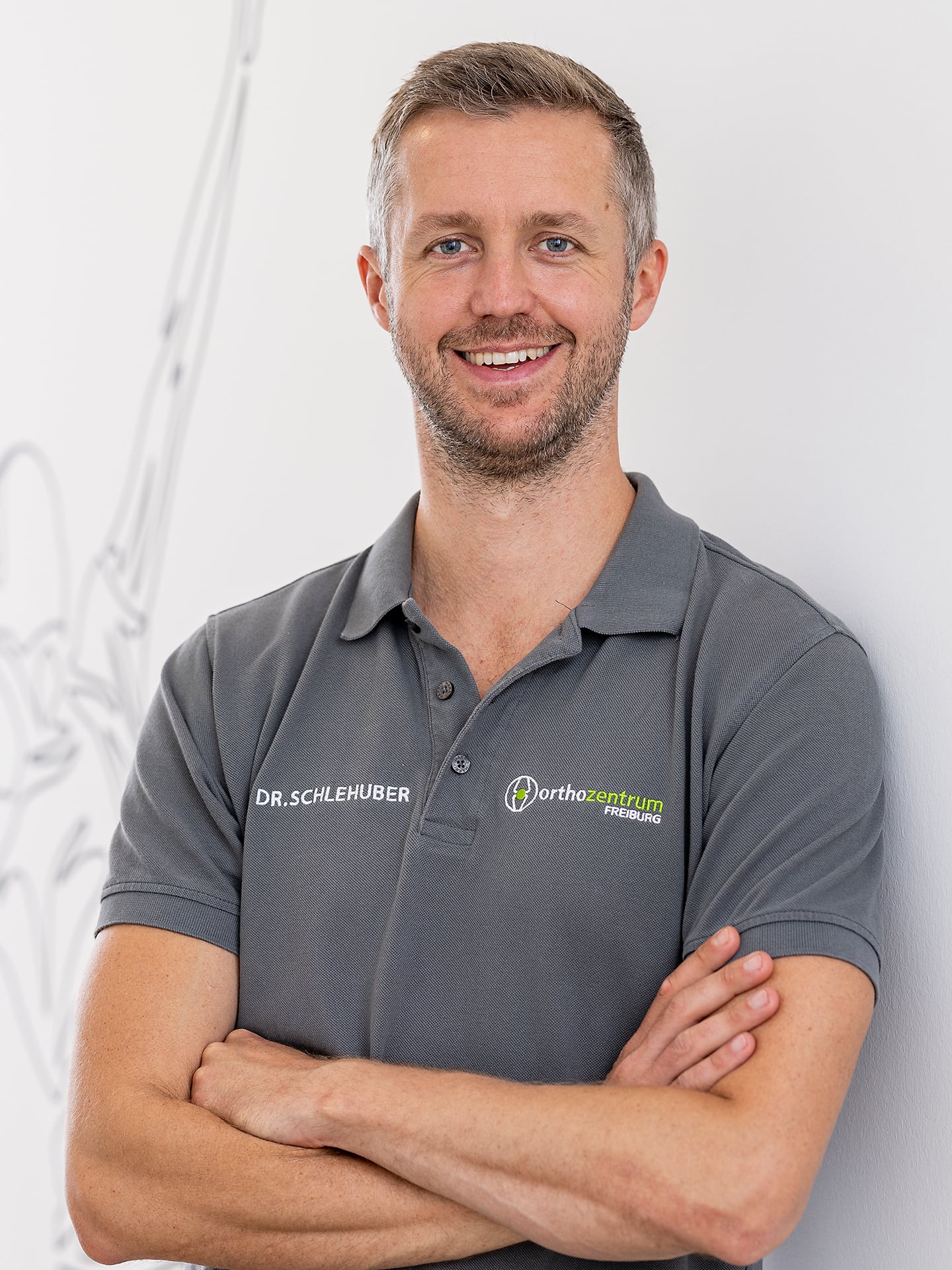Anatomy & Function
Die Werferschulter beschreibt Beschwerden, die durch funktionelle und strukturelle Veränderungen des Schultergelenks im Zuge von Überkopf- und Wurfsportarten, wie zum Beispiel Schwimmen, Handball, Volleyball oder Tennis, entstehen.
Wurfbewegungen können in drei Phasen unterteilt werden: In der ersten Phase einer Wurfbewegung wird der Arm abgespreizt und maximal nach außen rotiert. Anschließend wird der Arm in der sogenannten Beschleunigungsphase nach vorne bewegt. Darauf folgt die Abbremsphase, die mit einer hohen Belastung des Schultergelenks, insbesondere der hinteren Anteile der Gelenkkapsel, einhergeht.
Durch repetitive Wurfbewegungen kommt es demnach sowohl zu enormen Belastungsspitzen im Schultergelenk als auch zu Anpassungsvorgängen, um ein möglichst optimales Werfen zu ermöglichen. Diese damit einhergehenden Veränderungen können im Verlauf zu strukturellen Verletzungen im Schultergelenk führen.
Das Schultergelenk gilt gleichzeitig als das beweglichste und komplizierteste Gelenk im menschlichen Körper, was mit einer Anfälligkeit für Beschwerden und Verletzungen einhergeht. Es besteht aus einem komplexen System aus Knochen, Bändern, Schleimbeuteln und Sehnen und wird von dem Oberarmkopf (Humeruskopf) und der Pfanne, die Teil des Schulterblatts (Scapula) ist, gebildet. Die Gelenkpfanne wird von einer Gelenklippe (Labrum) umgeben, das Schultergelenk von einer Gelenkkapsel. Über dem Gelenk liegt das Schulterdach (Akromion). Der Oberarmkopf ist im Verhältnis zu seiner Gelenkpfanne überdurchschnittlich groß, was zu einem großen Bewegungsumfang in der Schulter, aber auch zu einer gewissen Instabilität führt. Das Schultergelenk wird durch 4 Muskeln stabilisiert, die zusammen die sogenannte Rotatorenmanschette bilden. Die Supraspinatussehne läuft dabei genau zwischen dem Oberarmkopf und dem Schulterdach hindurch, sodass diese Sehne häufig bei einem Engpass-Syndrom der Schulter betroffen ist.
Symptoms & Complaints
Anzeichen für eine Werferschulter können sein:
- Schulterschmerzen bei Belastung
- Bewegungseinschränkungen (v.a. Innenrotation)
Typischerweise leiden Betroffene an belastungsabhängigen Schulterschmerzen, die insbesondere bei Wurfbewegungen auftreten und im Verlauf zunehmen. Zusätzlich kommt es durch die hohe Belastung der hinteren Gelenkkapsel zu einer Schrumpfung und Verdickung der Kapsel an besagter Stelle, was eine verminderte Innenrotation der Schulter mit sich bringt. Dieses Phänomen wird in Fachkreisen glenohumerales Innenrotationsdefizit (GIRD) genannt. Aufgrund der maximalen Außenrotation bei Wurfbewegungen kommt es gleichzeitig zu einer Dehnung der vorderen Gelenkkapsel und damit zu einer übermäßigen Außenrotationsfähigkeit im Vergleich zur Gegenseite.
Die Beschwerden können zu einer vorübergehenden Sportunfähigkeit führen, was die Lebensqualität der Betroffenen deutlich einschränkt.
Causes
Die übergeordnete Ursache der Werferschulter besteht in dem regelmäßigen Betreiben von Wurf- und Überkopfsportarten (Schwimmen, Handball, Volleyball, Tennis, Baseball, Basketball). Die repetitiven Wurfbewegungen können zu einer Überlastung des Schultergelenks und damit zu Mikrotraumata führen, was wiederum weitere Veränderungen mit sich zieht.
Ursachen für eine Werferschulter sind u.a.:
- Verdickung und Schrumpfung der hinteren Gelenkkapsel, Dehnung der vorderen Gelenkkapsel ⇒ verminderte Innenrotation, verstärkte Außenrotation
- Sekundäre strukturelle Schäden, z.B. Rotatorenmanschettenläsion, Bizepssehnenriss, inneres Impingement
- Muscular imbalances
Wie oben bereits erwähnt, kommt es insbesondere in der Abbremsphase von Wurfbewegungen zu einer enormen Belastung der hinteren Gelenkkapsel und damit zu einer Kontraktion der Kapsel, was die Innenrotationsfähigkeit des Schultergelenks einschränkt. Die ausgeprägte Außenrotation am Anfang der Wurfbewegungen führt zu einer Dehnung der vorderen Anteile der Gelenkkapsel, was wiederum eine verstärkte Außenrotationsfähigkeit mit sich bringt.
Die Folge sind Veränderungen in der Biomechanik des Schultergelenks und ggf. weitere sekundäre strukturelle Schäden. Es kommt unter anderem zu einem Hochstand des Oberarmkopfes, was das Entstehen eines inneren Impingements begünstigt. Beim inneren Impingement wird die Supraspinatussehne der Rotatorenmanschette nicht wie beim externen Impingement zwischen Oberarmkopf und Schulterdach eingeklemmt, sondern durch den Gelenkpfannenrand. Darüber hinaus können Entzündungen, Teilrisse und vollständige Rupturen der Rotatorenmanschette beobachtet werden. Auch Verletzungen der langen Bizepssehne (SLAP-Läsion), der Gelenkkapsel oder der Gelenklippe (Labrum) sind möglich.
Muskuläre Dysbalancen, die durch einseitige Belastungen entstehen, verstärken die Problematik zusätzlich.
Diagnosis
Unser zertifizierter Sportarzt Dr. med. Tarek Schlehuber wird Sie in einem ausführlichen Gespräch bezüglich Ihrer Beschwerden befragen. Anschließend findet eine gründliche Untersuchung des Schultergelenks im Hinblick auf den Bewegungsumfang und begleitende strukturelle Schäden statt. Typischerweise fallen dabei eine eingeschränkte Innenrotations- und eine verstärkte Außenrotationsfähigkeit auf. Anamnese und körperliche Untersuchung sind zur Diagnosestellung meist ausreichend.
Zum Ausschluss von strukturellen Schäden werden bildgebende Verfahren, wie eine Ultraschall- und/oder eine Kernspinuntersuchung (MRT), genutzt. Meist sind dort ebenfalls die typischen Veränderungen der Gelenkkapsel (Kontraktion der hinteren Anteile, Dehnung der vorderen Anteile) sichtbar.
Treatment
Das Ziel der Behandlung stellt die Wiederherstellung der ursprünglichen Leistungsfähigkeit und Lebensqualität dar.
Conservative therapy:
The following conservative therapies are available:
- Protection
- Physiotherapy
- Painkiller
- Cooling pads
Im Rahmen der initialen Behandlung sollten Patienten und Patientinnen unbedingt auf eine Entlastung ihres Schultergelenks achten. Die Dauer und das Ausmaß der Entlastung wird individuell in Absprache mit Ihrem/-r Arzt/Ärztin festgelegt und kann von einer leichten Reduktion und Veränderung der Belastung bis hin zu einer wochenlangen Sportpause reichen.
Einer der wichtigsten Bestandteile der Therapie ist die Durchführung einer Physiotherapie, die folgende Ziele verfolgt: Dehnung der hinteren Anteile der Gelenkkapsel, Kräftigung der umliegenden Muskulatur, Ausgleich von muskulären Ungleichgewichten, Verbesserung der Beweglichkeit (insbesondere der Innenrotationsfähigkeit).
Zur akuten Schmerzreduktion können die Patienten und Patientinnen kurzfristig Schmerzmittel aus der Gruppe der nichtsteroidalen Antirheumatika (NSAR) einnehmen und/oder ein Kühlpad, mit einem Küchenhandtuch umwickelt, auf die betroffene Stelle auflegen.
Operation:
Eine Operation kann beim Versagen konservativer Therapiemaßnahmen und/oder bei bestehenden strukturellen Schäden notwendig werden. In den allermeisten Fällen werden diese Operation minimal-invasiv (arthroskopisch) durchgeführt, d.h. es werden über wenige Zentimeter lange Hautschnitte eine Kamera mit Lichtquelle und ein Arbeitsinstrument eingeführt. Dabei können Veränderungen im Schultergelenk genauestens beurteilt und im Anschluss direkt behandelt werden.
Die Operationstechnik ist abhängig von der Verletzungskonstellation und patientenspezifischen Faktoren. Bei einer Rotatorenmanschettenläsion wird die abgerissene Sehne während der OP wieder am Oberarmknochen fixiert (Rotatorenmanschetten-Naht). Eine sogenannte SLAP-Läsion,d.h. ein Ein- oder Abriss der langen Bizepssehne am oberen Rand der Gelenkpfanne mit Einriss der Gelenklippe der Pfanne, kann ebenfalls arthroskopisch therapiert werden. Dabei wird die Sehne mittels Nahtanker im Bereich der Gelenkpfanne zusammen mit den abgelösten Labrumanteilen refixiert. Alternativ kann während der Operation die lange Bizepssehne durchtrennt werden (Tenotomie), die dann im Verlauf der Operation an anderer Stelle knöchern oder weichteilig wieder angeheftet werden kann (Tenodese).
Aftercare
Die Nachbehandlung ist abhängig von der durchgeführten Operation, siehe dazu Rotatorenmanschettenläsion und Bizepssehnenruptur.
FAQs

